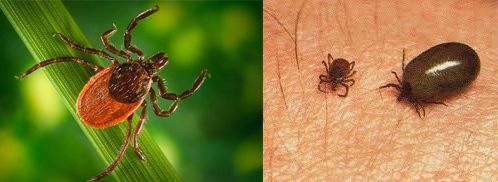AKC is a participant in affiliate advertising programs designed to provide a means for sites to earn advertising fees by advertising and linking to akc.org. If you purchase a product through this article, we may receive a portion of the sale.
Lyme disease, also known as Lyme borreliosis, is a bacterial illness that can be transmitted to humans, dogs, and other animals by certain species of ticks. It is caused by the spiral-shaped bacterium Borrelia burgdorferi, which is carried inside a tick and gets into a dog or person’s bloodstream through a tick bite. Once in the bloodstream, the bacteria can travel to different parts of the body and cause problems in specific organs or locations, such as joints, as well as overall illness.
Given the seriousness of Lyme disease, it’s important to be aware of tick prevention and treatment for dogs.
Where Do Ticks Live?
The ticks that carry Lyme disease are especially likely to be found in tall grasses, thick brush, marshes, and woods — waiting to latch onto your dog when they pass by. A tick can transmit the disease once it has been attached to a dog for 24 to 48 hours.
First named when a number of cases occurred in Lyme, Connecticut, in 1975, the disease can be hard to detect and can cause serious, ongoing health problems in both dogs and people.
Lyme disease happens in every state, but infection risks vary. Over 95% of cases are from the Northeast, the Upper Midwest, and the Pacific Coast, although with recent changes in deforestation, migrating deer, and bird populations, percentage rates in these areas are constantly changing.
A small number of cases crop up each year along the West Coast, especially in Northern California. In Canada, Lyme-positive dogs are found mostly in southern Ontario and southern Manitoba. A smaller number of cases are reported each year in southern Quebec and the Maritime Provinces.

How Do Ticks Get on People and Dogs?
Ticks don’t jump or fly—they can only crawl. They get onto their host by waiting at the tips of vegetation. When a dog or person brushes against a bush, for example, the tick quickly grabs on and then crawls to find a place to bite.
What Are the Symptoms of Lyme Disease in Dogs?
Lyme disease is, unfortunately, a fairly common canine disease. Typical symptoms in dogs include:
- Fever
- Loss of appetite
- Reduced energy
- Lameness (can be shifting, intermittent, and recurring)
- Generalized stiffness, discomfort, or pain
- Swelling of joints
Symptoms can progress to kidney failure in dogs, which can be fatal. Serious cardiac and neurological effects can also occur.

The primary carrier of Lyme disease is the black-legged tick (Ixodes scapularis), also called the “deer tick” or “bear tick.” The tick acquires the Lyme disease bacterium when it feeds on an animal that has been infected, such as a mouse, deer, or another mammal, and then transmits the bacterium to the next animal it feeds on. Image: CDC
How Are Dogs Tested for Lyme Disease?
Diagnosis is made by a combination of history, physical signs, and diagnostics. For dogs, the two blood tests for diagnosing Lyme disease are called the C6 Test and Quant C6 test. Veterinarians perform both.
The C6 test detects antibodies against a protein called “C6.” Presence of the antibodies suggests an active Lyme infection. The C6 antibodies can be detected three to five weeks after an infected tick bites a dog and may be found in the bloodstream, even before the dog shows signs of illness.
The next step is to do a Quant C6 test. This, along with urinalysis, will help determine if antibiotic treatment is necessary.
How Is Lyme Disease Treated?
Treatment includes antibiotics, usually for at least 30 days. This often resolves symptoms quickly, but in some cases, the infection will persist and prolonged medication may be needed. Treatment can also include other therapies aimed at resolving or relieving specific symptoms.
Can I Catch Lyme Disease From My Dog?
Dogs are not a direct source of infection for people. Lyme disease can’t be transmitted from one pet to another, nor from pets to humans, except through tick bites. However, a carrier tick could come into your house on your dog’s fur and get on you.
If your dog is diagnosed with Lyme disease, you and any other pets have probably been in the same outdoor environment and may also be at risk. So it is a good idea to consult with your physician and veterinarian to see whether you should test other pets or family members.

Other Canine Diseases Carried by Ticks
Other less common—but serious—bacterial tick-borne diseases in dogs include anaplasmosis and babesiosis.
Anaplasmosis can involve symptoms similar to those of Lyme disease. Babesiosis can present with a wide range of symptoms, from sudden and severe shock, high fever, and dark urine to a slowly progressing infection with more subtle clinical signs. Diagnosis of both diseases includes blood tests similar to those used to check for Lyme disease.
Sometimes, dogs and people can become sick with “co-infection” of multiple tick-borne diseases, where more than one type of disease-causing bacteria is transmitted through a tick bite. This situation can make diagnosis and treatment even more challenging and difficult.
Preventing Lyme Disease and Other Tick-borne Illnesses
Recommendations on preventing ticks include these from Dr. Jerry Klein, Chief Veterinary Officer for the AKC:
- Inspect your dogs and yourself daily for ticks. After walks through the woods or grassy settings, check yourself and your dog for ticks. When inspecting your dog for ticks, look especially on the feet (and between toes), on lips, around eyes, ears (and inside ears), near the anus, and under the tail.
- Remove ticks immediately. The quicker you find them, the less likely your dog will be to contract a secondary illness related to tick bites. Learn the proper method of removing ticks from dogs. Invest in a pair of fine tweezers designed to remove ticks. If you are unable to do so, consult with a veterinarian.
- Ask your veterinarian to conduct a tick check at each exam. They’ll be able to find any you may have missed.
- Use one of the veterinary-approved flea and tick preparations to prevent ticks from jumping on your dog. Speak to your veterinarian to find the product that’s most appropriate for your dog.
- Keep grass mowed as short as possible. Avoid walking into grassy patches in areas where ticks are common if you can.
- Get your dog vaccinated. Vaccination could prevent your dog from getting Lyme disease. They may not be appropriate for some dogs, so discuss this with your vet.

